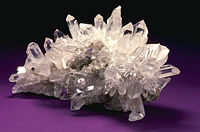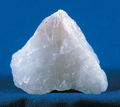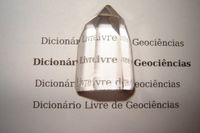Quartz

 |
| Quartz crystal group from Arkansas. |
 |
| Rutilated quartz crystal |
 |
| Milk quartz |
 |
| A synthetic quartz crystal grown by the hydrothermal method, about 19 cm long and weights about 127 grams. |
 |
| Quartz crystal showing transparency. |
 |
| Rose quartz |
|
|
Quartz is the most abundant mineral in the Earth's continental
crust. It is made up of a lattice of silica (SiO2) tetrahedra. Quartz has a hardness of 7
on the Mohs scale and a density of 2.65 g/cm³.
Quartz belongs to the rhombohedral crystal system. The ideal crystal shape is a six-sided
prism terminating with six-sided pyramids at each end. In nature quartz crystals are often
twinned, distorted, or so intergrown with adjacent crystals of quartz or other minerals as
to only show part of this shape, or to lack obvious crystal faces altogether and appear massive.
Well-formed crystals typically form in a 'bed' that has unconstrained growth into a void,
but because the crystals must be attached at the other end to a matrix, only one termination
pyramid is present. A quartz geode is such a situation where the void is approximately
spherical in shape, lined with a bed of crystals pointing inward.
Varieties
Pure
quartz is colorless or white, colored varieties include rose quartz, amethyst, smoky quartz,
milky quartz, and others. Quartz goes by an array of different names. The most important distinction
between types of quartz is that of macrocrystalline (individual crystals visible to the unaided eye)
and the microcrystalline or cryptocrystalline varieties (aggregates of crystals visible only under
high magnification). Chalcedony is a generic term for cryptocrystalline quartz. The cryptocrystalline
varieties are either translucent or mostly opaque, while the transparent varieties tend to be macrocrystalline.
Although many of the varietal names historically arose from the color of the mineral,
current scientific naming schemes refer primarily to the microstructure of the mineral.
Color is a secondary identifier for the cryptocrystalline minerals, although it is a
primary identifier for the macrocrystalline varieties. This does not always hold true.
| Major Varieties |
| Chalcedony | Any cryptocrystalline quartz, although generally only used for white or lightly colored material. Otherwise more specific names are used. |
| Agate | Multi-colored, banded chalcedony, semi-translucent to translucent |
| Onyx Agate | where the bands are straight, parallel and consistent in size. |
| Jasper | Opaque chalcedony, typically red to brown |
| Aventurine | Translucent chalcedony with small inclusions (usually mica) that shimmer. |
| Tiger's eye | Fibrous gold to red-brown coloured quartz, exhibiting chatoyancy. |
| Rock crystal | Clear, colorless |
| Amethyst | Purple, transparent |
| Citrine | Yellow to reddish orange to brown, greenish yellow |
| Prasiolite | Mint green, transparent |
| Rose quartz | Pink, translucent, may display diasterism |
| Rutilated quartz | Contains acicular (needles) inclusions of rutile |
| Milk quartz | White, translucent to opaque, may display diasterism |
| Smoky quartz | Brown to grey, opaque |
| Morion | Dark-brown, opaque |
| Carnelian | Reddish orange chalcedony, translucent |
Not all varieties of quartz are naturally occurring. Prasiolite, an olive colored material,
is produced by heat treatment; natural prasiolite has also been observed in Lower Silesia in
Poland. Although citrine occurs naturally, the majority is the result of heat-treated amethyst.
Carnelian is widely heat-treated to deepen its color.
Due to natural quartz being so often twinned, much of the quartz used in industry is synthesized.
Large, flawless and untwinned crystals are produced in an autoclave via the hydrothermal process;
emeralds are also synthesized in this fashion. While these are still commonly referred to as quartz,
the correct term for this material is silicon dioxide.
Occurance
Quartz occurs in hydrothermal veins and pegmatites. Well-formed crystals may reach several meters
in length and weigh hundreds of kilograms. These veins may bear precious metals such as gold or silver,
and form the quartz ores sought in mining. Erosion of pegmatites may reveal expansive
pockets of crystals, known as "cathedrals."
Quartz is a common constituent of granite, sandstone, limestone, and many other igneous,
sedimentary, and metamorphic rocks.
History
The name "quartz" comes from the German "Quarz", which is of Slavic origin (Czech miners called
it kremen). Other sources insist the name is from the Saxon word "Querkluftertz", meaning cross-vein ore.
Quartz is the most common material identified as the mystical substance maban in Australian
Aboriginal mythology. It is found regularly in passage tomb cemeteries in Europe in a burial
context, eg. Newgrange or Carrowmore in the Republic of Ireland. The Irish word for quartz is
grian cloch, which means 'stone of the sun'.
Roman naturalist Pliny the Elder believed quartz to be water ice, permanently frozen after
great lengths of time. (The word "crystal" comes from the Greek word for ice.) He supported
this idea by saying that quartz is found near glaciers in the Alps, but not on volcanic
mountains, and that large quartz crystals were fashioned into spheres to cool the hands.
He also knew of the ability of quartz to split light into a spectrum. This idea persisted until at least the 1600s.
Nicolas Steno's study of quartz paved the way for modern crystallography. He discovered
that no matter how distorted a quartz crystal, the long prism faces always made a perfect 60 degree angle.
Charles Sawyer invented the commercial quartz crystal manufacturing process in Cleveland,
Ohio, United States. This initiated the transition from mined and cut quartz for electrical
appliances to manufactured quartz.
Quartz's piezoelectric properties were discovered by Jacques and Pierre Curie in 1880.
The quartz oscillator or resonator was first developed by Walter Guyton Cady in 1921.
George Washington Pierce designed and patented quartz crystal oscillators in 1923.
Warren Marrison created the first quartz oscillator clock based on the work of Cady and Pierce in 1927.
Quartz crystals are rotary polar (see rotary polarization) and have the ability to
rotate the plane of polarization of light passing through them. They are also highly
piezoelectric, becoming polarized with a negative charge on one end and a positive
charge on the other when subjected to pressure. They will vibrate if an alternating
electric current is applied to them. This proves them to be highly important in
commerce for making pressure gauges, oscillators, resonators and watches.
Piezoelectricity
Quartz crystals have piezoelectric properties, that is they develop an electric potential
upon the application of mechanical stress. An early use of this property of quartz crystals
was in phonograph pickups. One of the most common piezoelectric uses of quartz today is as a
crystal oscillator. The quartz clock is a familiar device using the mineral. The resonant frequency
of a quartz crystal oscillator is changed by mechanically loading it, and this principle is used for
very accurate measurements of very small mass changes in the quartz crystal microbalance and in
thin-film thickness monitors.